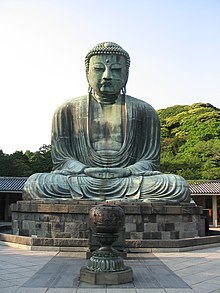Kōtoku-in
The Kōtoku-in ( Japanese高 徳 院) is a Buddhist temple in the Japanese city of Kamakura . It houses the Great Buddha (Japanese 大 仏daibutsu ), one of the most important representations of the Buddha Amitabha (Japanese Amida ).
history
In the place of today's figure, the Kōtoku-in originally had a carved wooden Buddha figure in a wooden shrine. The first plans to erect a bronze statue of Buddha can be traced back to the priest Toe no Joko in 1236, to the time of the Kamakura shogunate under the rule of Hojo Yasutoki .
In 1252, the artists Ōno-Gorōemon and Tanji-Hisatomo began to erect a bronze sculpture of the Shaka - Nyorai -Buddha, paid for by donations .
Originally, today's figure was covered with gold leaf and was located inside a wooden temple building that had a footprint of 44 meters × 42.5 meters. However, it collapsed first in 1334 and then in 1369, and was torn to the ground by a tsunami in 1498 . After that, no reconstruction was undertaken; the statue has been in the open ever since.
Fundraising for the rebuilding of the temple began in 1879. However, the plan was abandoned in 1889 and the money donated was used to beautify and enlarge the site.
A restoration of the statue took place in 1960 and 1961, during which the neck of the figure was strengthened and improved earthquake security measures were taken.
Properties and appearance
| Weight | 121 t |
| height | 13.35 m |
| face | 2.35 m |
| eye | 1 m |
| ear | 1.9 m |
| mouth | 0.82 m |
| Knee to knee | 9.1 m |
| Thumb circumference | 0.85 m |
The daibutsu is 13.35 meters high and consists of several separately cast and artfully assembled parts. It weighs 121 tons. The sculpture can be entered for a fee via an entrance on the back of the base and viewed from the inside. Two large viewing windows donated in 1736 can be opened at the back.
The representation of Daibutsu in Kōtoku-in follows the style of the Buddhist art of the Kamakura period (1192-1333) in Japan.
As is usually the case, Buddha Amitabha is shown here in a sitting meditation position. His hands rest in his lap ( Dhyana - Mudra ), while the index fingers are raised in this special shape and form two triangles when the thumbs touch ( Amitabha Dhyana Mudra , Japanese Amida Jō-in ). Among the nine gestures of greeting (Japanese Raigō ) with which Amitabha greets the deceased in the "Pure Land" according to the Japanese tradition of Amitabha Buddhism , this is the highest, called Jōbon Jōshō . His feet are hidden under the robe, which indicates Amitabha's position as one of the most important esoteric, tantric Buddhas.
photos
Daibutsu at the time of the cherry blossom
Others
- The first western travel reports about the Kōtoku-in date from the early 17th century: in 1607 a Father Rodrigues visited the place, and in 1618 an English captain named Saris.
- Some of the foundation stones of the hall, which was destroyed in 1498, were still in their original places around the figure until the beginning of the 20th century.
- The two bronze lanterns to the left and right of the statue were donated in January 1712 and had tapered ends until the end of the 19th century.
- Rudyard Kipling dedicated a few verses of poetry to the Buddha statue in the preface to his 1901 novel " Kim ".
- Lafcadio Hearn wrote a travel report in one chapter in his work “Isuzo” in 1905 (German 1909).
Web links
- Information at A Guide to Kamakura (English)
- Information at Kamakura Citizens Net (English)
Coordinates: 35 ° 19 '0.8 " N , 139 ° 32' 8.6" E







